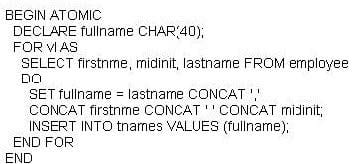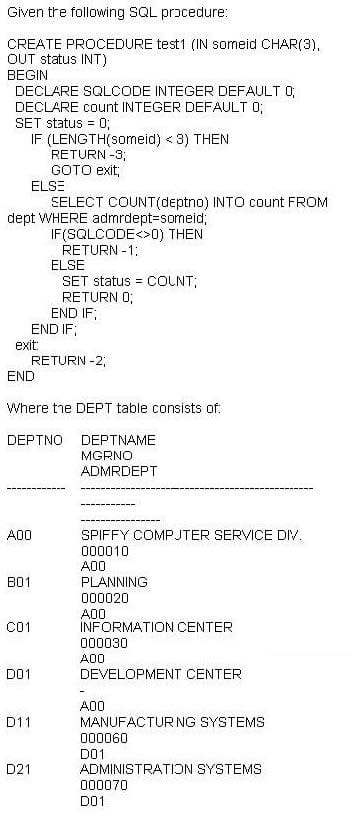Exam Details
Exam Code
:C2090-545Exam Name
:DB2 9.7 SQL Procedure DeveloperCertification
:IBM Certified Solution DeveloperVendor
:IBMTotal Questions
:115 Q&AsLast Updated
:Apr 16, 2025
IBM IBM Certified Solution Developer C2090-545 Questions & Answers
-
Question 61:
For which types of servers can you use IBM Data Studio to create and manage SQL procedures?
A. DB2 for LUW, DB2 for z/OS, Oracle
B. DB2 for LUW, DB2 for z/OS, SQL Server
C. DB2for LUW, DB2 for z/OS, MySQL
D. DB2 for LUW, DB2 for z/OS, Sybase
-
Question 62:
Which command can be used to convert literals in SQL statements to parameter markers to avoid compilation of similar SQL statements?
A. UPDATE DB CFG USING STMT_CONC ON
B. UPDATE DB CFG USING LIT_PARM ON
C. UPDATE DB CFG USING CURSOR_SHARING FORCED
D. UPDATE DB CFG USING CURSOR_SHARING ON
-
Question 63:
Which of the following can be done while debugging a SQL procedure with IBM Data Studio?
A. Change the order of statements being executed.
B. Edit the procedure and continue.
C. Change the value of any variables used.
D. Re-executethe current statement.
-
Question 64:
Which action is supported by Data Studio in the SQL procedure lifecycle?
A. Create global temporary tables to use in the SQL procedure.
B. Debug the SQL procedure.
C. Use auto complete SQL statements.
D. Create user-define types in the SQL procedure.
-
Question 65:
What are two ways toexecute an SQL procedure using IBM Data Studio? (Choose two.)
A. Open a SQL editor, enter the appropriate CALL statement and hit the Run button.
B. Right-click on the SQL procedure and select the Run option from the menu.
C. Open a Command Line Processorwindow from IBM Data Studio and execute the appropriate CALL statement.
D. Open a text editor, enter the appropriate CALL statement and hit the run button.
E. Right-click on the SQL procedure and select the Open Visual Explain option from the menu.
-
Question 66:
Which tool can be used to get an Explain plan for all SQL statements used in a unit of work?
A. db2look
B. DB2 Command Center
C. Data Studio
D. db2exfmt
-
Question 67:
Click the Exhibit button.

Which statement correctly describes the result of the FOR loop shown in the exhibit?
A. FULLNAME isset to the last name of the employee, followed by a comma, the first name, a blank space, and the middle initial. Only the last value for FULLNAME is inserted into table TNAMES.
B. FULLNAME is set to the last name of the employee, followed by a comma, thefirst name, a blank space, and the middle initial. Only the first value for FULLNAME is inserted into table TNAMES.
C. FULLNAME is set to the last name of the employee, followed by a comma, the first name, a blank space, and the middle initial for each row. Each value for FULLNAME is inserted into table TNAMES in alphabetical order.
D. FULLNAME is set to the last name of the employee, followed by a comma, the first name, a blank space, and the middle initial for each row. Each value for FULLNAME is insertedinto table TNAMES.
-
Question 68:
How is the FOR statement distinct from other conditional statements?
A. FOR statements are evaluated at the completion of each iteration of the loop.
B. FOR statements are evaluated before each iteration of the loop.
C. FOR statements have a terminating condition clause.
D. FOR statements are used to iterate over rows in a defined read-only result set.
-
Question 69:
Click the Exhibit button.

If the procedure TEST1 shown in the exhibit is called with the value 'A00'specified for the SOMEID parameter, what is the expected return code?
A. 0
B. -1
C. -2
D. -3
-
Question 70:
Which steps must be followed to return a result set from an SQL procedure?
A. 1. Create the procedure using the DYNAMIC RESULT SETS clause. 2.Declare the cursor.
3.
Open the cursor in the SQL procedure.
4.
Close the cursor.
5.
Return to the application.
B. 1. Create the procedure using the DYNAMIC RESULT SETS clause.
2.
Declare the cursor using the WITH RETURN clause.
3.
Open the cursor in the SQL procedure.
4.
Return to the application.
C. 1. Create the procedure using the WITH RETURN clause.
2.
Declare the cursor using the DYNAMIC RESULT SETS clause.
3.
Open the cursor in the SQL procedure.
4.
Return to the application.
D. 1. Create the procedure using the WITH RETURN clause.
2.
Declare the cursor using the DYNAMIC RESULT SETS clause.
3.
Open the cursor in the SQL procedure.
4.
Close the cursor.
Related Exams:
A2090-303
Assessment: IBM InfoSphere DataStage v9.1 AssessmentA2090-304
Assessment: IBM InfoSphere QualityStage v9.1 AssessmentA2090-305
Assessment: IBM InfoSphere Information Analyzer v9.1 AssessmentA2090-421
Assessment: InfoSphere DataStage v8.5A2090-422
Assessment: InfoSphere QualityStage v8.5 AssessmentA2090-423
Assessment: Information Analyzer v8.5 AssessmentA2090-545
Assessment: DB2 9.7 SQL Procedure Developer AssessmentA2090-610
Assessment: DB2 10.1 Fundamentals - AssessmentA2090-730
Assessment: DB2 9 Fundamentals-AssessmentA2180-272
Assessment: IBM WebSphere Message Broker V8.0, Solution Development
Tips on How to Prepare for the Exams
Nowadays, the certification exams become more and more important and required by more and more enterprises when applying for a job. But how to prepare for the exam effectively? How to prepare for the exam in a short time with less efforts? How to get a ideal result and how to find the most reliable resources? Here on Vcedump.com, you will find all the answers. Vcedump.com provide not only IBM exam questions, answers and explanations but also complete assistance on your exam preparation and certification application. If you are confused on your C2090-545 exam preparations and IBM certification application, do not hesitate to visit our Vcedump.com to find your solutions here.